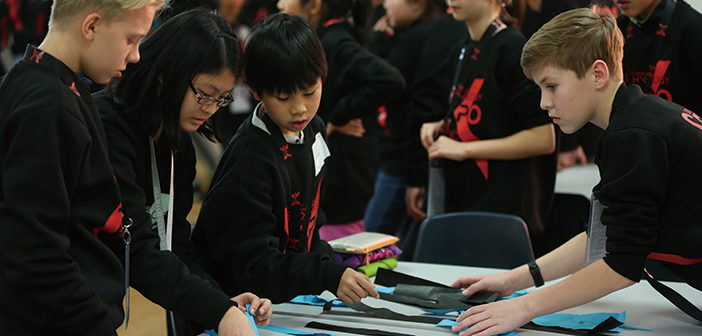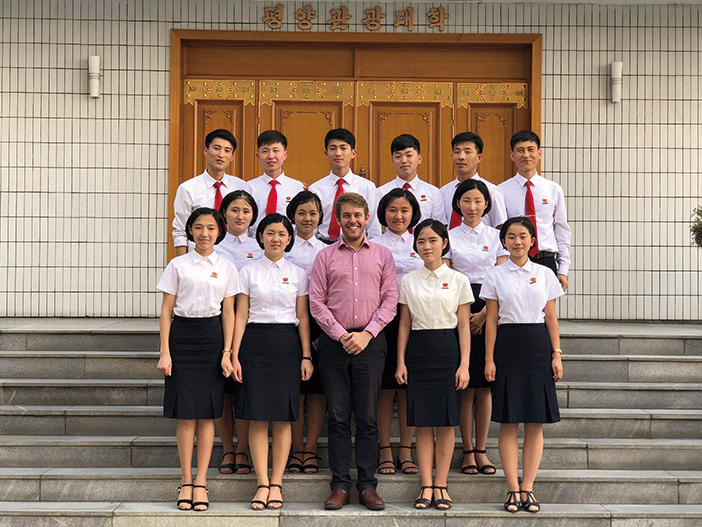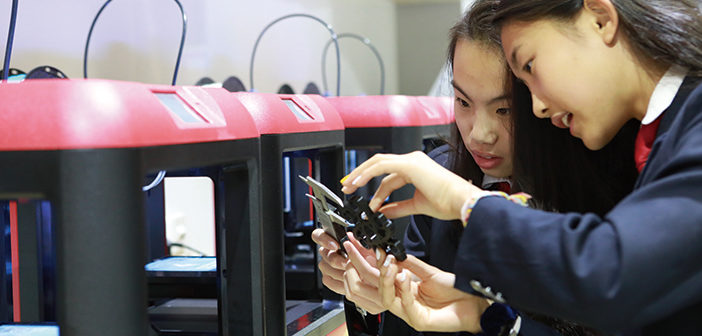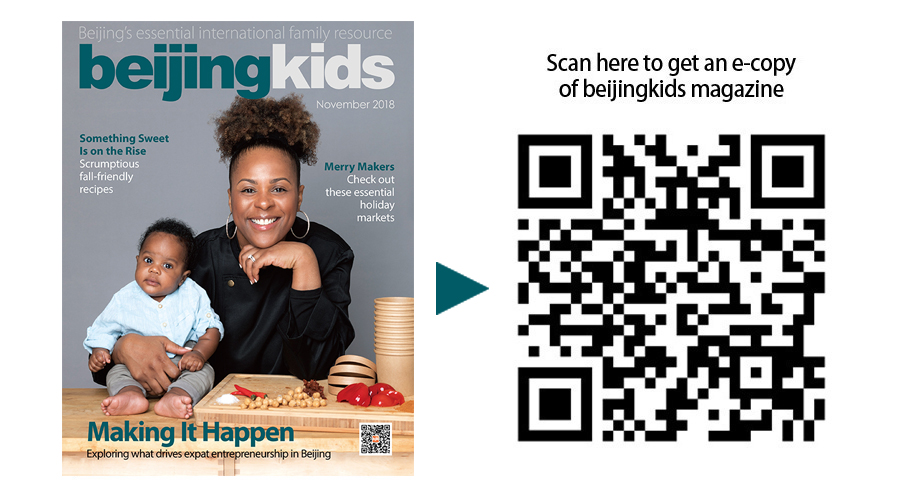“How long is it going to take?” ponders ninth-grader Tobias, who is huddled around a laptop with his two project teammates. “What if they want a really complicated design?”
They had the problem. How to guarantee business efficiency and customer satisfaction at the same time? The solution was much harder to identify. For several weeks, the Dulwich College Beijing (DCB) students inched toward the answer. By mid-October, they had one: a template was the only way to design custom-made USBs on demand. So the team created one, using a 3D printer. From there they were free to crank out dozens more USBs — holiday-themed, monogrammed, you name it. And with that, their startup concept, The Handy Dandies, was that much closer to living up to its name.
These business projects are somewhat hypothetical, but every step is a rigorous education in reality beyond graduation. Sometimes, these semester-long collaborative ventures result in actual businesses outside the classroom. But this enterprise approach to education emphasizes perseverance over profit. And ideas are incubated and hatched within Dulwich’s studio-lab curriculum known as SE21 — shorthand for STEM and Enterprise Skills for the 21st Century (also conveniently, DCB founding school Dulwich College sits in Southeast London, in the SE21 postcode). Now in its second year, SE21 offers students a more enterprise-driven approach to learning science, technology, engineering, and math.

Enterprise Education underpins a model of teaching and learning based on engaging in projects, collaboration, creating value, and solving problems. It means developing an ability to invent opportunities.
Dulwich students dress the part; they wear dark-blue suits and red neckties. Divided into groups of three, each teammate morphs into a digital designer, a coder, or a marketing expert. Collectively, they collaborate: the teens come up with an idea, develop a business plan, pitch to an investor (the school), even forecast a profit margin, all on a tight deadline. The tasks are enough to make professionals twice their age reach for the nearest fidget spinner — which, by the way, the students also happen to design and make in the shop. Sometimes, though, the spinners just don’t spin. And that’s O.K.
“In our classrooms, we encourage failure,” says STEM teacher Yosef Karasik, as he tests a fidget spinner fresh from a 3D printer. “Failure is a skill. At the end of the day, we want self-regulated learners. And one big aspect of self-regulation is self-evaluation and self-reflection.”
For two years now, that introspective, enterprising spirit has been nurtured inside a sleek, brightly-lit space on Dulwich’s sprawling campus. SE21’s creators think of it as a “mindset,” and indeed it is something of an intellectual playground: humming 3D printers, rows of mobile workstations, a student-assembled Formula One car track running the length of a studio wall. Prior to SE21’s arrival at Dulwich, Karasik says, “innovation existed in a different form here. Now, it’s explicit.”
“We were questioning how much value design was adding to our curriculum,” says Natalie Stevens, Dulwich’s Head of Technology. “Were our students taking away what they needed to? Were they gaining the skills they needed to become engineers, designers, or architects? The answer was not always, so we had to change the focus.”
The question then became: How should SE21 & Technology better prepare students to enter the world’s top universities?
Throughout his presidency, Barack Obama pushed to expand student access to STEM education, and estimated that the US workforce would need 1 million more STEM graduates by 2022. In China, that need is far greater and much more immediate.

A recent Peking University study of Chinese colleges and universities reported a low career survival rate for graduates who studied entrepreneurship. And the Global Entrepreneurship Monitor noted that China has one of the world’s highest fear-of-failure rates, which prevents many graduates from ever attempting to get their vision off the ground.
“I think there’s a real disconnect between Chinese education and the realities of where you’re going to go when you graduate,” says Julian Fisher, who two years ago co-founded Venture Education, an Enterprise Education curriculum now taught in 25 Beijing schools. “I think a lot of students have never realized what’s it like to be completely at the bottom.”
This downward trend in post-graduation attitudes toward success reflects the paramount importance of a curriculum like the one used within SE21, where students gain not only technical skills but also what teachers call “soft skills” essential to making it in the real world: teamwork combined with critical thinking and communications skills.
Fisher, who also chairs the Education Forum for the British Chamber of Commerce in China, acknowledges that the concept of Enterprise Education may appear to contradict the success stories of billionaire entrepreneurs like Mark Zuckerberg and the late Steve Jobs.
But there’s a major difference between Enterprise Education and Entrepreneurship Education, Fisher argues: the former is about the mindset, the latter is often only about venture creation and money. “One of the weaknesses of the entrepreneurial ecosystem is that notion of, ‘I just need a great idea, and then I’ll get funding, and then I’ll get rich,’” he says.
Instead, Fisher points out, consider the 13-year-old boy from the UK who made a nuclear fusion reactor. Or the 13-year-old Mongolian girl who hunts with eagles. “These are not kids making money,” he says. “The point is they are having an impact.”
At their core, Enterprise Education curriculums like SE21 prioritize the inculcation of the value of the design process, fostering confidence, making ideas happen, and figuring out how those concepts will help people. Rather than consulting a textbook on how to run a business, improve a societal ill, or make the general population happier, students are pushed to rely less on classroom instruction and more on group instinct and judgment in order to see a project through.
Some SE21 students are as young as 13, and many already talk like techies. Buzzwords suited to Silicon Valley — “beta phase,” “bigger vision,” “mockup business experience” — roll off the tongue. At the center of SE21 sits what is currently known as the War Room, where project strategies detailing Dulwich’s upcoming Enterprise Fair are scrawled in pen on the glass walls. “We don’t always come to the best solution first,” admits Jadelle, a tenth-grader in her second year of SE21.

Jonathan, one of the program’s youngest students, understands Jadelle’s observation all too well. Every day during lunch hour, he drops by one of SE21’s makerspace rooms to inspect a pet project he enjoys tinkering with. He realizes a mistake the moment he removes two neon-green plastic pieces from the 3D-printer.
“I’m gonna need to design some more parts for this marble run,” Jonathan says with a slight grin. “They don’t fit together.”
“They almost fit together,” offers his STEM teacher, Andrew Walton. “Just a smidgen more tolerance, and they would fit.”
One aspect of learning from failure comes from breaking down an idea’s strengths, weaknesses, opportunities, threats — and then just going for it. Jonathan does not appear frustrated; in fact, his miscalculation illuminates something bigger. And he says he’s now better prepared to take another shot at improving the intricacies of track design.
In class, SE21 students consult a system to help guide them through the many stages of an idea: empathizing (understanding a client’s need); ideating (brainstorming); prototyping (creating something); testing; and, finally, reflecting. Students are told they might fail at any point. But this sort of structure keeps them honest with themselves, encourages them to research further, and gives them the confidence to start all over again.
 During our visit to SE21 on a Friday afternoon, there was a remarkable lack of visible stress inside the classrooms. With so much at stake, with so much time and work invested in an idea that could fall apart at any time, the students manage to hold it all together.
During our visit to SE21 on a Friday afternoon, there was a remarkable lack of visible stress inside the classrooms. With so much at stake, with so much time and work invested in an idea that could fall apart at any time, the students manage to hold it all together.
“Their understanding of business, it’s already there,” says business teacher Li Jian Newman. “What makes it such a pleasure to teach students like these is they’re just so willing to get involved, to think about things differently, to really think about the world from a different perspective.”
Take the group tasked with creating the artwork for a brochure advertisement. Their big idea: Merchiful, a solution to improving the complicated world of gift-giving. Say your aunt knows you’re a fan of K-pop music. But that’s all she knows, and she has no clue where to begin shopping. Instead of frantically searching Taobao for the perfect gift, Merchiful will curate and creatively package a K-pop box set for her.
“It’s kind of ambitious,” admits Cathy, Merchiful’s marketing captain, whose command of an elevator pitch would be the envy of most adults. “We asked for the most funding out of all of the groups.” Students apply for up to RMB 750 from the STEM program to start a business. Any funds raised above the amount of the loan are reinvested into STEM projects or donated to charitable causes.
Once the teachers approve a project idea, the students spend eight weeks developing it. Along the way, they manage orders, manufacturing, sales, and product distribution. One student group is working on how to effectively market the upcycling of discarded wine bottle corks into miniature, magnetic plant pots. “It’s not exactly our concept,” one teammate says. “But we’re gonna make it ours. We’re trying to think more of the aesthetic factor.”
Down the hall during lunch hour, students staff and stock the school’s student-run shop, called the Friends Shop, with supplies and healthy snacks. Sixteen-year-old William manages it with a team of classmates and says he rarely encounters a smooth week. “One little mistake, one little communication error may result in a day without sufficient student shifts” he says.
William decided to take things up a notch in the name of health after he contacted a startup in Shenzhen. His idea was to rent the company’s vending machines to replace the school’s food dispensing machines. The shop has since served as William’s portal into the risks and challenges associated with running a business, warts and all. “The biggest thing that textbooks can never teach you is the logistical and organizational issues,” he says. “Learning, I don’t think, has to be confined to traditional academia. Collaboration and empowerment are everything.”
Asked about the value of enterprise education versus entrepreneurship education, William says students “should be careful of” aspiring to be the next Jeff Bezos of Amazon, for example. “I think we should develop our own unique way of doing things,” he says, “instead of trying to become someone else.”
“It’s finding a new way to challenge yourself,” adds tenth-grader Tiare. “That doesn’t mean it just has to be with a textbook; it can be creative as well.”
SE21 hosts the Technology department which every student takes in sixth to eighth grade and then optional from ninth to twelfth grade. SE21 is a hive of activity throughout the day. The space encompasses a swarm of lessons and extracurriculars, exams, and clubs. But it is the enterprise philosophy learned here that shapes and pushes young minds toward graduation and beyond. It’s where students discover that enterprise is less about making money for themselves and more about creating value for other people. It’s a mindset where playing it safe often inhibits progress, and where failure is often the only sure path to success.
“Dulwich provides us with a degree of freedom,” says Mark, a tenth-grader. “We aren’t forced into anything. Rather, the gates are open for us to enter the real world.”

This article appeared in the beijingkids November 2018 Beijing Makers issue
Photos: Courtesy of Dulwich College Beijing and Julian Fisher





1 Comment
Pingback: Beijing Dad Develops Course to Teach Life Lessons